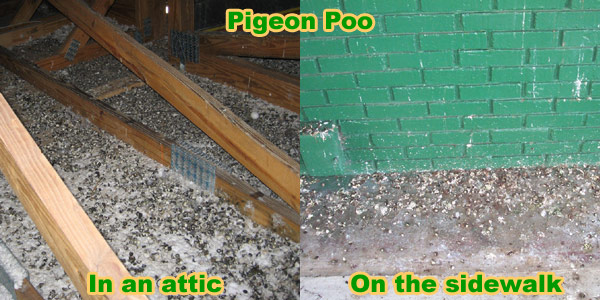- info@wildlife-removal.com
Call us for help in your town
Wildlife Removal Education
Diseases from Pigeon Poop or Feces
Need pigeon removal in your hometown? We service over 500 USA locations! Click here to hire us in your town and check prices - updated for year 2020.
Is pigeon feces dangerous to touch or breathe? It is never a good idea to come in contact with any animal
or bird droppings, and proper hygiene is a sure fire way to make sure that no infection is ever experienced.
That being said, there are some concerns when it comes to pigeons, as they tend to move into buildings easily.Read more about Best Ways to Remove Pigeon Feces from Concrete.
There are three human diseases that have a link to pigeons. They are: histoplasmosis, psittacosis and cryptococcosis.

Histoplasmosis is an illness caused with a fungus that is found worldwide in certain soils and yes, in pigeon droppings. Normal activities can lead to a person being exposed to the fungus; however you would have to breathe in a huge
amount of the fungus for it to cause infection.
Symptoms generally manifest within ten days of exposure and include fever, fatigue plus chest pains. However, most people don’t develop infections even though large amounts of
people are exposed to this fungus through normal activities.
Crytococcosis is a disease also caused by a fungus. But as with histoplasmosis, this fungus is found worldwide in soil and is associated with pigeon guano, but not exclusively. Only people with compromised immune systems are
really at risk of contracting this disease from pigeon droppings.
Psittacosis is a disease brought on by a bacterial infection. This disease is rare, and most often affects parrot and parrot-like birds like cockatiels and parakeets, but can also affect pigeons. If the birds’ droppings become dry, the bacteria can become airborne and infect a human being.
Symptoms generally occur about ten days after infection. They include, fever, and chill, rash, headache and fatigue. However, this disease can be treated simply enough with an antibiotic.
It is worth mentioning that fewer and fewer cases of this disease are reported in the United States each year according to the CDC. And in 70% of the reported cases the infection was from a pet bird and not feral pigeon guano. People most at
risk are pet shop owners or employees, bird owners and those with compromised immune systems.
It is always best to follow good hygiene practices and dispose of any animal dropping in a contained and safe way. When dealing with pigeons wearing gloves and a surgical mask can help to prevent any concern about disease when
dealing with guano. There are also chemicals on the market that can be used to clean up the mess made by birds in a safe manner.
Click here to go back to my main bird removal page to learn more about dangers and diseases from pigeon droppings.


















